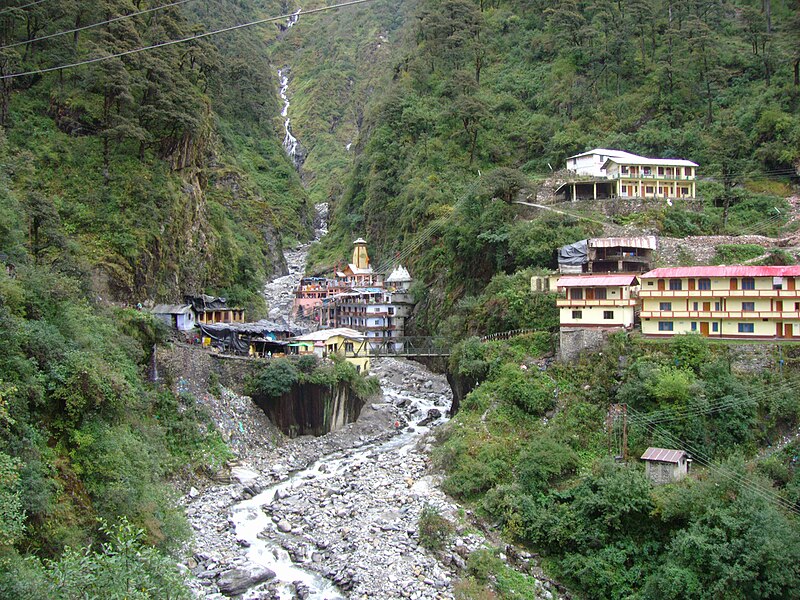As in Islam, in the Hindu religion there are pilgrimages (yatra) which each of the faithful should complete once in a lifetime to cleanse themselves spiritually and achieve Moksha (salvation). The greatest is the Char Dham Yatra (Four Abodes Pilgrimage), to temples in Puri (Odisha state), Rameswaram (Tamil Nadu), Dwarka (Gujarat), and Badrinath (Uttarhand).
But there is also an important yatra just in Uttarakhand state, India's northernmost, in the Garhwal Himalayas bordering Nepal and Tibet, and known for its mountainous natural beauty and also for its plethora of Hindu temples and shrines; its own "four abodes" - including of course Badrinath - are referred to as the Chotra Char Dham. As such, every year they are visited by tens of thousands of pilgrims during a six-month period from spring through fall, with the peak months with the most pleasant weather being April/May and October/November (this year two of the yatra temples opened on April 26, but of course pilgrims have not been allowed to come due to the coronavirus lockdown - meaning the pilgrimage has this year been postponed until travel opens up again).
Many devotees embark on their char dham tour from the cities of Rishikesh or Haridwar, and according to tradition, it should be undertaken in the following order:
Yamunotri
With a population of around 30,000, this town up 3,293 meters (10,804 feet) in the mountains is traditionally considered the seat of the Hindu goddess Yamuna, and it's the origin of the Yamuna River - one of India's holiest, and the main tributary of the Ganges. The late-19th-century temple opens every Akshaya Tritiya (spring festival) and can be accessed from the hamlet of Hanuman Chatti on foot or horseback. There are also a number of thermal springs near the temple, such as Surya Kund, famed for its healing powers; devotees dip rice and potatoes in the spring waters, then bring them to the temple as a offering to the goddess.
Gangotri
Seven hours east of Yamunotri by road and set amidst mountains and forests, the second stop on the yatra is a tiny village (population around 600) whose temple was built in the 18th century and also opens on the first day of Akshaya Tritiya with a special procession. The Ganga (Ganges) River originates here as the Bhagirithi River, so Gangotri is considered the seat of its personification, the goddes Ganga. The special ritual offering of light to the goddess takes place from 8 pm onwards in the temple itself as well as on the banks of the river. Gangotri National Park is a popular ecotourism reserve nearby.
Kedarnath
Another tiny village, 3,583 m (11,755 ft) up in the Himalayas about an hour and a half south of Gangotri, Kedarnath is home to another famous temple (of uncertain age, but referenced as far back as the 7th century), held to be the home of the god Shiva and with many carvings featuring mythological stories. Nearby there are also meditation caves and a number of kunds (pools), such as Retkund and Rudhirkund, each wiith their own importance. Devotees of Shiva believe that to be born or to die here is a blessing and that those who die here become one with Shiva himself.
Badrinath
The final dham, located on the Alaknanda River about 8½ hours east of Kedarnath, is about four times the size and is home to the largest temple of the four towns, dedicated to Vishnu (badri refers to an edible berry that grows in this area and nath refers to Lord Vishnu). Though to be a Buddhist temple converted to Hinduism in the 8th century, Badrinath Temple is divided into three parts: the Garbha Griha (main shrine area), which features 15 idols, including a one-meter-tall black-stone image of Vishnu; the Darshan Mandap, where devotional rituals called pujas are conducted; and the Sabha Mandap, where devotees can spend time praying and reflecting. Just below the temple is a series of hot sulphur springs thought to be medicinal, and in which many pilgrims bathe before visiting the temple.
Though many Hindus do this circuit on their own, there are also many organized Char Dham tour packages available throughout the year.

Comments